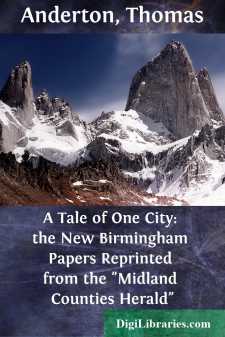Categories
- Antiques & Collectibles 13
- Architecture 36
- Art 48
- Bibles 22
- Biography & Autobiography 813
- Body, Mind & Spirit 142
- Business & Economics 28
- Children's Books 17
- Children's Fiction 14
- Computers 4
- Cooking 94
- Crafts & Hobbies 4
- Drama 346
- Education 46
- Family & Relationships 57
- Fiction 11829
- Games 19
- Gardening 17
- Health & Fitness 34
- History 1377
- House & Home 1
- Humor 147
- Juvenile Fiction 1873
- Juvenile Nonfiction 202
- Language Arts & Disciplines 88
- Law 16
- Literary Collections 686
- Literary Criticism 179
- Mathematics 13
- Medical 41
- Music 40
- Nature 179
- Non-Classifiable 1768
- Performing Arts 7
- Periodicals 1453
- Philosophy 64
- Photography 2
- Poetry 896
- Political Science 203
- Psychology 42
- Reference 154
- Religion 513
- Science 126
- Self-Help 84
- Social Science 81
- Sports & Recreation 34
- Study Aids 3
- Technology & Engineering 59
- Transportation 23
- Travel 463
- True Crime 29
A Tale of One City: the New Birmingham Papers Reprinted from the "Midland Counties Herald"
by: Thomas Anderton
Description:
Excerpt
I.
PROLOGUE.
The present century has seen the rise and development of many towns in various parts of the country, and among them Birmingham is entitled to take a front place. If Thomas Attwood or George Frederick Muntz could now revisit the town they once represented in Parliament they would probably stare with amazement at the changes that have taken place in Birmingham, and would require a guide to show them their way about the town—now a city—they once knew so well. The material history of Birmingham was for a series of years a story of steady progress and prosperity, but of late years the city has in a political, social, and municipal sense advanced by leaps and bounds. It is no longer "Brummagem" or the "Hardware Village," it is now recognised as the centre of activity and influence in Mid-England; it is the Mecca of surrounding populous districts, that attracts an increasing number of pilgrims who love life, pleasure, and shopping.
Birmingham, indeed, has recently been styled "the best governed city in the world"—a title that is, perhaps, a trifle too full and panegyrical to find ready and general acceptance. If, however, by this very lofty and eulogistic description is meant a city that has been exceptionally prosperous, is well looked after, that has among its inhabitants many energetic, public-spirited men, that has a good solid debt on its books, also that has municipal officials of high capabilities with fairly high salaries to match—then Birmingham is not altogether undeserving of the high-sounding appellation. Many of those who only know Birmingham from an outside point of view, and who have only lately begun to notice its external developments, doubtless attribute all the improvements to Mr. Chamberlain's great scheme, and the adoption of the Artisans' Dwellings Act in 1878. The utilisation of this Act has certainly resulted in the making of one fine street, a fine large debt, and the erection of a handful of artisans' dwellings. The changes, however, that culminated in Mr. Chamberlain's great project began years before the Artisans' Dwellings Act became law.
The construction of the London and North Western Railway station—which, with the Midland Railway adjunct, now covers some thirteen acres of land—cleared away a large area of slums that were scarcely fit for those who lived in them—which is saying very much. A region sacred to squalor and low drinking shops, a paradise of marine store dealers, a hotbed of filthy courts tenanted by a low and degraded class, was swept away to make room for the large station now used by the London and North Western and Midland Railway Companies.
The Great Western Railway station, too, in its making also disposed of some shabby, narrow streets and dirty, pestiferous houses inhabited by people who were not creditable to the locality or the community, and by so doing contributed to the improvement of the town. Further, the erection of two large railway stations in a central district naturally tended to increase the number of visitors to the growing Midland capital, and this, of course, brought into existence a better class of shops and more extended trading....


